Bamboo Scrimber as a Sustainable Material for Chairs: A Property Study Based on the Finite Element Method
Abstract
:1. Introduction
2. Materials and Methods
2.1. Comparison of Material Parameters
2.2. Chair Load Analysis
2.2.1. Geometric Modeling
2.2.2. Loading Mode
3. Results and Discussion
4. Conclusions
Author Contributions
Funding
Institutional Review Board Statement
Informed Consent Statement
Data Availability Statement
Conflicts of Interest
References
- Yu, W.J. Current status and future development of bamboo scrimber industry in China. China Wood Ind. 2019, 17, 1–4. [Google Scholar]
- Wu, J.S.; Chen, H.; Lian, C.P.; Wu, Z.H. Research on application of bamboo in modern furniture design. China For. Prod. Ind. 2021, 58, 51–54. [Google Scholar]
- Wang, L. Review of industrial utilization ways of bamboo plants. J. Anhui Agric. Univ. 2011, 39, 10294–10296. [Google Scholar]
- Li, T. A study of the application of bamboo in interior design. Ind. Des. 2018, 1, 98–99. [Google Scholar]
- Huang, S. A Study on the Design of New-Sino-Style Furniture Made of Recombinant Bamboo. Ph.D. Dissertation, Nanjing Forestry University, Nanjing, China, 2012. [Google Scholar]
- Shi, D.; Wang, F.; Yu, W. The study on the application of recombinant bamboo in modern furniture design. Packag. Eng. 2013, 34, 62–66. [Google Scholar]
- Liu, X.; Zhang, Z.F. Study on the design of outdoor furniture made of Bamboo scrimber. Appl. Mech. Mater. 2013, 397–400, 907–910. [Google Scholar] [CrossRef]
- Rao, F.; Ji, Y.; Li, N.; Zhang, Y.; Chen, Y.; Yu, W.J. Outdoor bamboo-fiber-reinforced composite: Influence of resin content on water resistance and mechanical properties. Constr. Build. Mater. 2020, 261, 120022. [Google Scholar] [CrossRef]
- Rao, F.; Zhu, X.; Zhang, Y.; Ji, Y.; Lei, W.; Li, N.; Zhang, Z.; Chen, Y.; Yu, W.J. Water resistance and mechanical properties of bamboo scrimber composite made from different units of Bambusa chungii as a function of resin content. Constr. Build. Mater. 2022, 335, 127250. [Google Scholar] [CrossRef]
- Zhang, B. Recombined bamboo, a new sustainable development material for good quality furniture. Furniture 2008, 164, 64–66. [Google Scholar]
- Zhang, F.Q.; Chen, S.Y. Research on the application of bamboo characteristics in modern product design. Furniture 2018, 39, 18–20+65. [Google Scholar]
- Zhang, W.; Zhang, X. Reviewing the relationship between materials and processing technology with product form by studying the design of chairs. Packag. Eng. 2010, 25, 35–38. [Google Scholar]
- Guan, M. Shrinkage and swelling properties of bamboo scrimber. J. Bamboo Res. 2009, 28, 38–41. [Google Scholar]
- Huang, S.Y.; Wu, Z.H. Study on joint property of oval-tenon of reconstituted bamboo furniture. Chin. For. Sci. Technol. 2011, 25, 40–44. [Google Scholar]
- Fu, Y.; Fang, H.; Dai, F. Study on the properties of the recombinant bamboo by finite element method. Compos. B Eng. 2017, 115, 151–159. [Google Scholar] [CrossRef]
- Zheng, F. Research on the Design of Bamboo Scrimber Courtyard Furniture. Ph.D. Dissertation, Central South University of Forestry & Technology, Changsha, China, 2019. [Google Scholar]
- Liu, Y.; Jiang, X.; Sun, D.; Zou, W.; Wang, Z. Folding furniture design based on recombinant bamboo. China For. Prod. Ind. 2020, 57, 56–59. [Google Scholar]
- Wang, Z.; He, Q. Application of recombinant bamboo in new Chinese furniture shape design. Packag. Eng. 2016, 37, 155–159. [Google Scholar]
- Chen, F. The Research on the Thinking and Methods about Designing Chairs. Ph.D. Dissertation, Central South University of Forestry & Technology, Changsha, China, 2006. [Google Scholar]
- Zhou, J.; Wu, Y. The origin and development of the round-backed armchair. Furniture 2019, 40, 6265. [Google Scholar]
- Li, Z.; Chen, C.; Yang, L. The cultural connotation of Ming style round-backed armchair and its redesign in contemporary era. Furniture 2021, 42, 56–59. [Google Scholar]
- Fu, Y. The application of the finite element method to verify the use of recombinant bamboo material in furniture. J. Bamboo Res. 2016, 35, 48–54. [Google Scholar]
- Cai, K.; Chen, Y. A review of finite element analysis in furniture structure. Furnit. Inter. Des. 2015, 9, 18–19. [Google Scholar]
- Wang, F.; Zhang, J.; Li, S. The application of FEM in furniture construction design. China For. Prod. Ind. 2009, 36, 41–43. [Google Scholar]
- Chen, S.; Ke, Q.; Guo, H.; Zhang, F. Application of finite element software ANSYS on structural design of solid wood furniture. China For. Prod. 2014, 228, 41–42. [Google Scholar]
- Zhou, H. Research on the Design of Mortise and Tenon Furniture under the Mixing and Matching of Different Materials. Ph.D. Dissertation, Sichuan Normal University, Chengdu, China, 2021. [Google Scholar]
- TC41-SAC GB/T 1939-2009; Method of Testing in Compression Perpendicular to Grain of Wood. Standards Press of China: Beijing, China, 2009.
- TC41-SAC GB/T 1938-2009; Standard Test Method for Tensile Strength of Wood. Standards Press of China: Beijing, China, 2009.
- TC41-SAC GB/T 1935-2009; Standard Test Method for Compressive Strength of Wood Grain. Standards Press of China: Beijing, China, 2009.
- TC41-SAC GB/T 1943-2009; Method for Determination of the Modulus of Elasticity in Compression Perpendicular to Grain of Wood. Standards Press of China: Beijing, China, 2009.
- GB/T 10000-88; National Standard of the People’s Republic of China: Basic Dimensions of the Human Body and Their Applications. China Standards Press: Beijing, China, 1988.
- GB/T 10357.3-2013; Test of Mechanical Properties of Furniture—Part 3: Strength and Durability of Chairs and Stools. Standards Press of China: Beijing, China, 2013.
- Wang, Z.; Xu, W.; Zhu, Y. Mechanical analysis of solid wood chair frame structure based on ABAQUS. China For. Prod. Ind. 2023, 27, 63–65. [Google Scholar]
- Wu, Z.Y. Recognizing the number of freeze-thaw cycles of Phyllostachys edulis based on BP neural network. J. Wildland Fire Sc. 2022, 40, 93–96. [Google Scholar]
- National Health Commission of the People’s Republic of China. Report on nutrition and chronic disease status of Chinese residents. Acta Nutr. Sin. 2020, 42, 521. [Google Scholar]
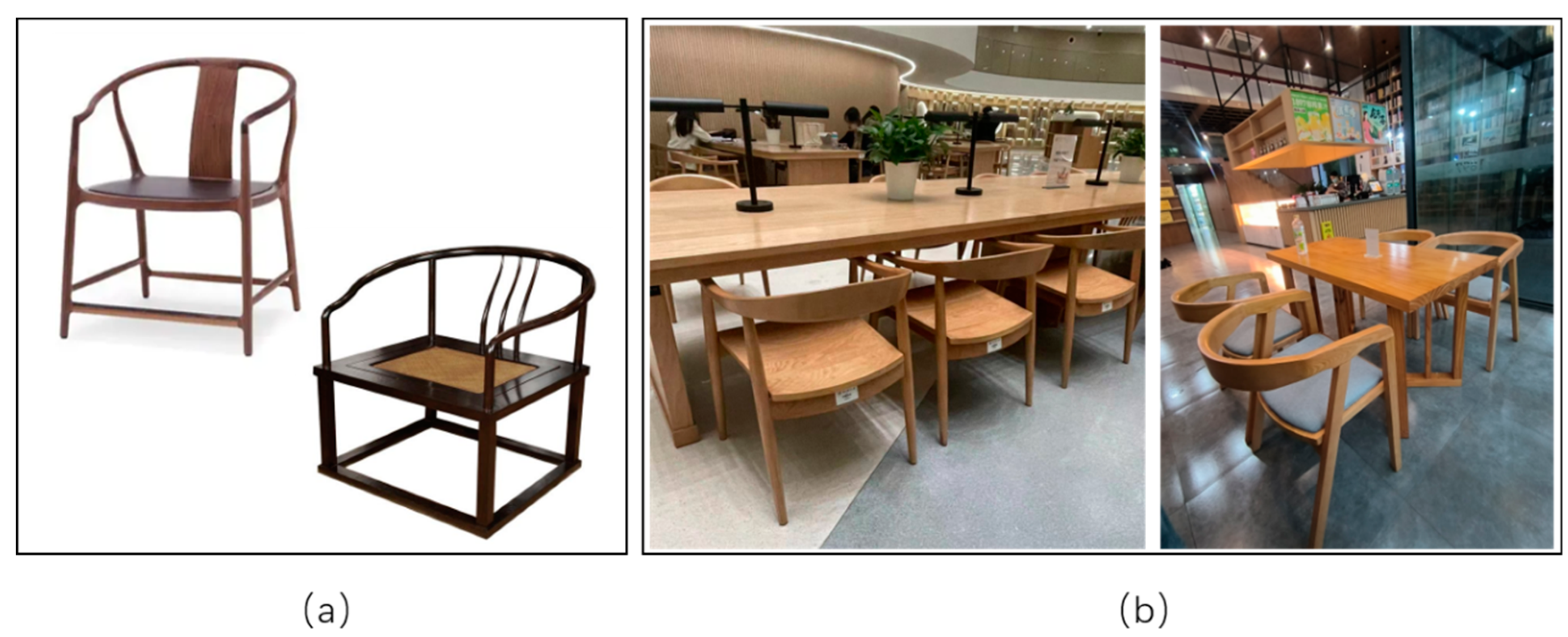

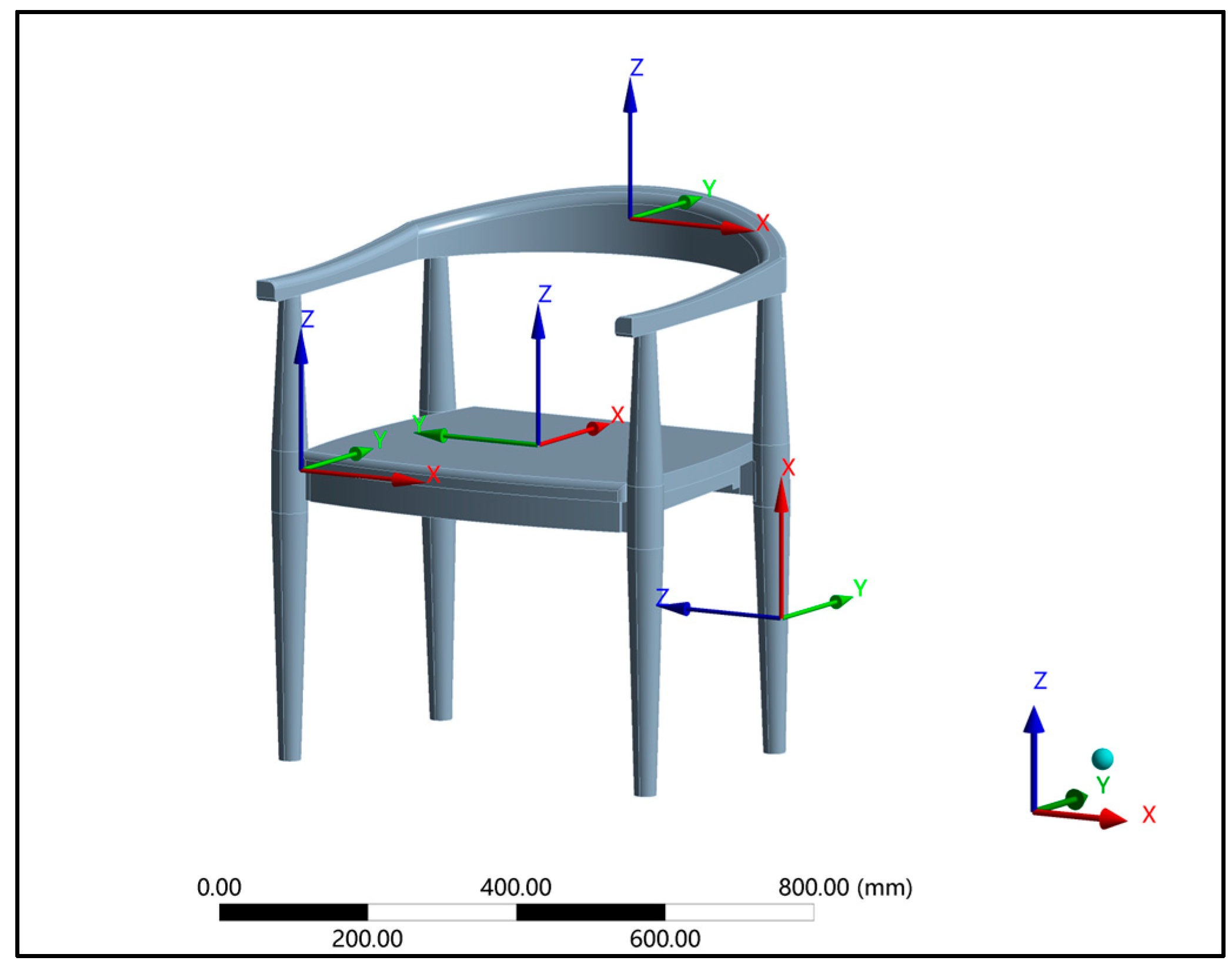
| Materials | Density (g/cm3) | EL (MPa) | ER (MPa) | ET (MPa) | μRT | μLR | μLT | GLT (MPa) | GLR (MPa) | GTR (MPa) |
|---|---|---|---|---|---|---|---|---|---|---|
| Bamboo scrimber | 1.11 | 15,466 | 3007 | 1204 | 0.440 | 0.304 | 0.336 | 1347 | 823 | 567 |
| Ash wood | 0.67 | 15,790 | 1516 | 827 | 0.71 | 0.46 | 0.51 | 896 | 1310 | 269 |
| Beech | 0.75 | 13,700 | 2240 | 1140 | 0.75 | 0.45 | 0.51 | 1060 | 1610 | 460 |
| Condition | Load | Load View | Exert Load | Balance Load | Chair Leg Restraint |
|---|---|---|---|---|---|
| 1 | Seat surface |  | 1500 N vertical load applied to seat surface | Frictionless confinement | |
| 2 | Backrest | 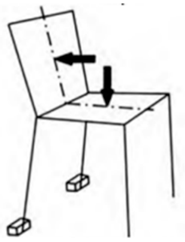 | 500 N load applied to backrest | 1100 N vertical load applied to seat surface | Two rear chair legs set with fixed restraints |
| 3 | Front legs | 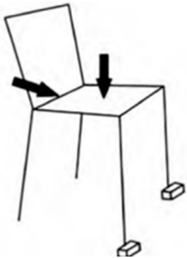 | 500 N forward horizontal load applied to seat panel rear | 1100 N vertical load applied to seat surface | Two front chair legs set with fixed restraints |
| 4 | Lateral legs |  | 500 N horizontal load applied to right side of seat panel | 1100 N vertical load applied to seat surface | Left two chair legs set with fixed constraints |
| 5 | Lateral load on armrests | 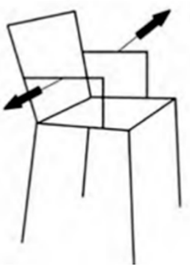 | 400 N load applied outward horizontally and vertically from both armrests | Frictionless confinement | |
| 6 | Vertical load on armrests |  | 800 N vertical load applied to one armrest | 800 N load applied to seat surface on opposite side | Frictionless confinement |
| Material | Bamboo Scrimber | Ash | Beech |
|---|---|---|---|
| Maximum deformation (mm) | 0.69 | 1.13 | 0.80 |
| Maximum deformation position | Chair leg extremity | Chair leg extremity | Chair leg extremity |
| Maximum stress (MPa) | 5.70 | 5.53 | 5.28 |
| Maximum stress position | Seat surface | Seat surface | Seat surface |
| Deformation | 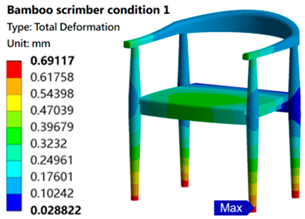 |  |  |
| Stress | 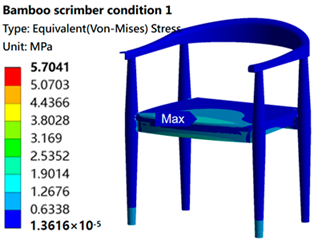 | 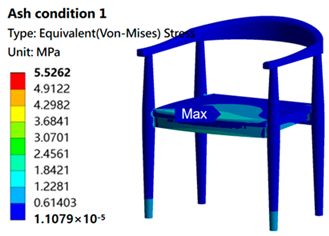 | 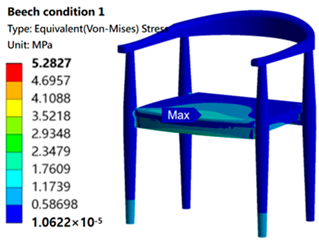 |
| Material | Bamboo Scrimber | Ash | Beech |
|---|---|---|---|
| Maximum deformation (mm) | 12.50 | 18.16 | 13.48 |
| Maximum deformation position | Backrest | Backrest | Backrest |
| Maximum stress (MPa) | 29.98 | 28.15 | 26.91 |
| Maximum stress position | Chair leg | Chair leg | Chair leg |
| Deformation | 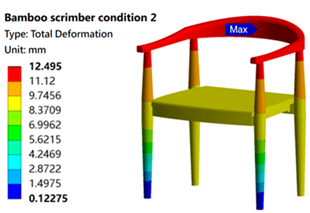 |  | 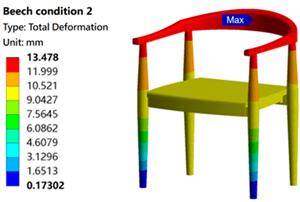 |
| Stress |  | 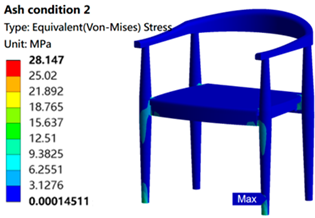 | 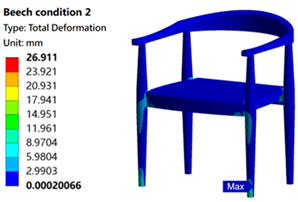 |
| Material | Bamboo Scrimber | Ash | Beech |
|---|---|---|---|
| Maximum deformation (mm) | 5.36 | 7.55 | 5.70 |
| Maximum deformation position | Backrest | Backrest | Backrest |
| Maximum stress (MPa) | 29.97 | 27.69 | 27.40 |
| Maximum stress position | Junction of seat surface and legs | Junction of seat surface and legs | Junction of seat surface and legs |
| Deformation |  |  | 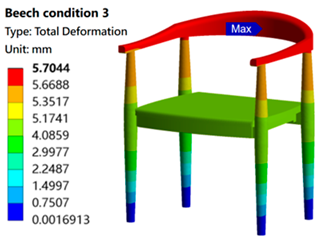 |
| Stress | 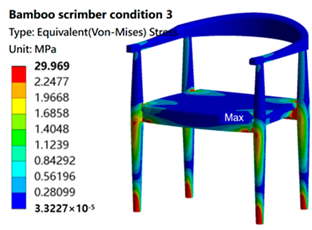 |  | 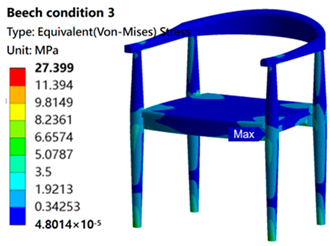 |
| Material | Bamboo Scrimber | Ash | Beech |
|---|---|---|---|
| Maximum deformation (mm) | 7.87 | 11.03 | 8.38 |
| Maximum deformation position | Backrest | Backrest | Backrest |
| Maximum stress (MPa) | 46.27 | 38.94 | 38.50 |
| Maximum stress position | Lower half of the left seat leg | Lower half of the left seat leg | Lower half of the left seat leg |
| Deformation | 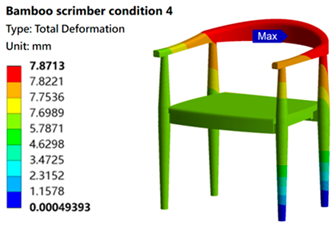 |  | 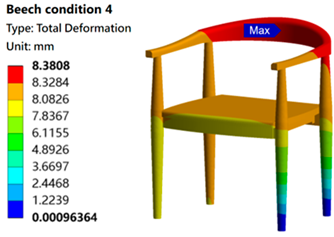 |
| Stress |  |  |  |
| Material | Bamboo Scrimber | Ash | Beech |
|---|---|---|---|
| Maximum deformation (mm) | 0.77 | 0.76 | 0.86 |
| Maximum deformation position | Armrest front | Armrest front | Armrest front |
| Maximum stress (MPa) | 22.23 | 23.18 | 21.64 |
| Maximum stress position | Junction of seat surface and front legs | Junction of seat surface and front legs | Junction of seat surface and front legs |
| Deformation | 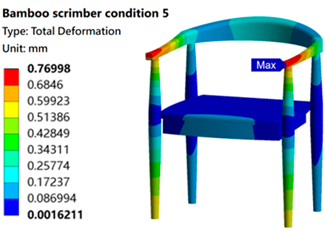 |  |  |
| Stress | 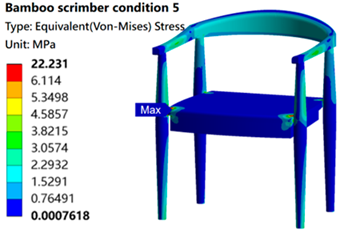 | 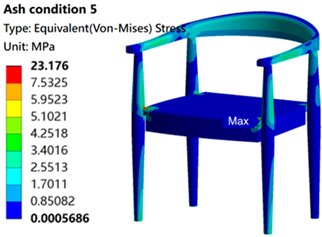 |  |
| Material | Bamboo Scrimber | Ash | Beech |
|---|---|---|---|
| Maximum deformation (mm) | 0.30 | 0.30 | 0.34 |
| Maximum deformation position | Middle of left armrest | Middle of left armrest | Middle of left armrest |
| Maximum stress (MPa) | 10.42 | 10.06 | 10.42 |
| Maximum stress position | Middle of left armrest | Middle of left armrest | Middle of left armrest |
| Deformation | 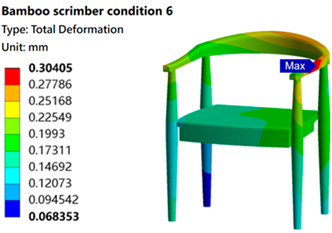 | 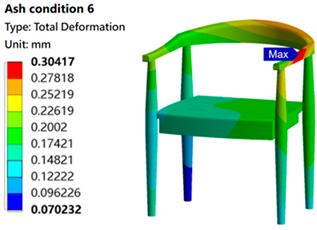 |  |
| Stress | 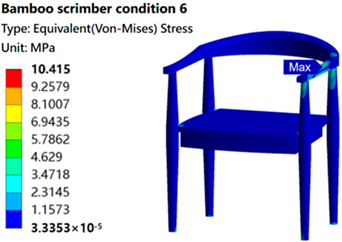 | 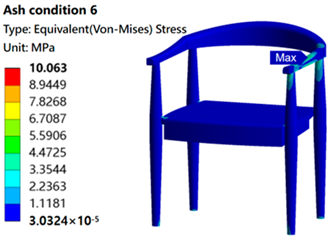 |  |
Disclaimer/Publisher’s Note: The statements, opinions and data contained in all publications are solely those of the individual author(s) and contributor(s) and not of MDPI and/or the editor(s). MDPI and/or the editor(s) disclaim responsibility for any injury to people or property resulting from any ideas, methods, instructions or products referred to in the content. |
© 2024 by the authors. Licensee MDPI, Basel, Switzerland. This article is an open access article distributed under the terms and conditions of the Creative Commons Attribution (CC BY) license (https://creativecommons.org/licenses/by/4.0/).
Share and Cite
Duan, Z.; Zu, Q.; Rao, F. Bamboo Scrimber as a Sustainable Material for Chairs: A Property Study Based on the Finite Element Method. Sustainability 2024, 16, 5357. https://doi.org/10.3390/su16135357
Duan Z, Zu Q, Rao F. Bamboo Scrimber as a Sustainable Material for Chairs: A Property Study Based on the Finite Element Method. Sustainability. 2024; 16(13):5357. https://doi.org/10.3390/su16135357
Chicago/Turabian StyleDuan, Zhengjie, Qing Zu, and Fei Rao. 2024. "Bamboo Scrimber as a Sustainable Material for Chairs: A Property Study Based on the Finite Element Method" Sustainability 16, no. 13: 5357. https://doi.org/10.3390/su16135357






